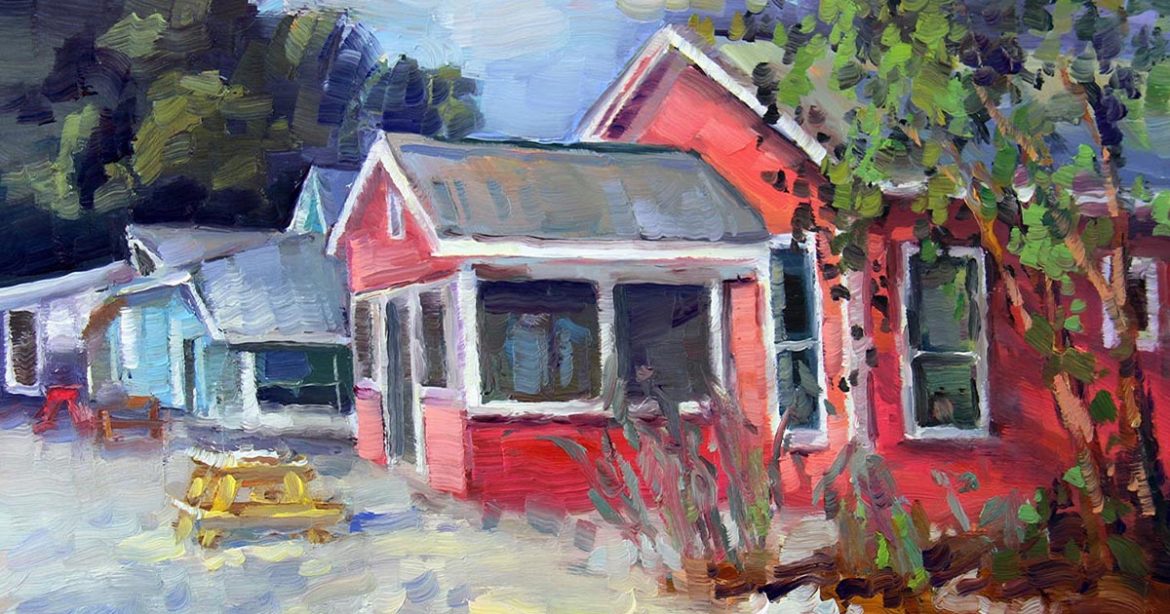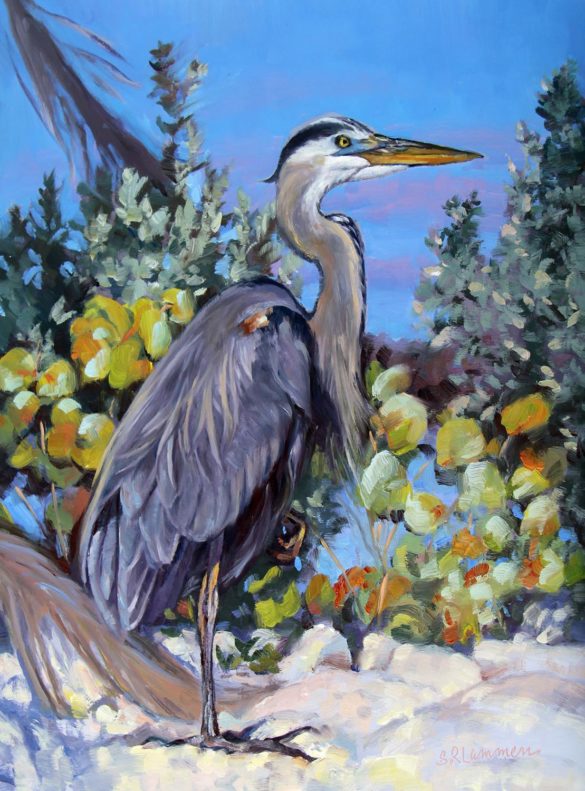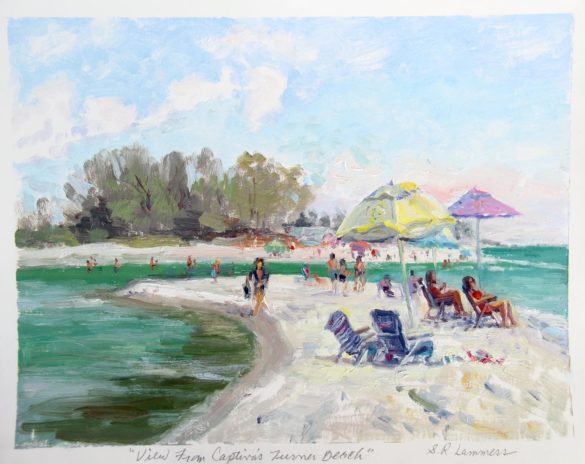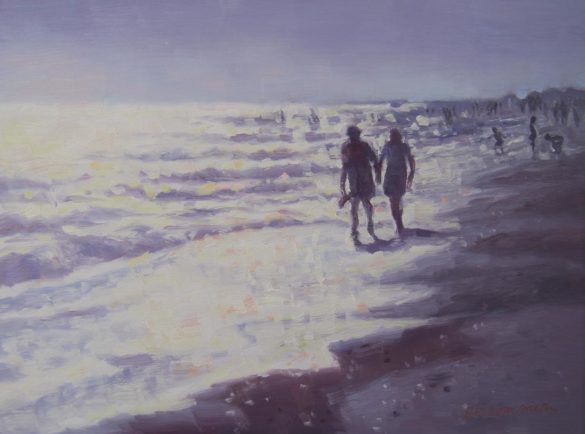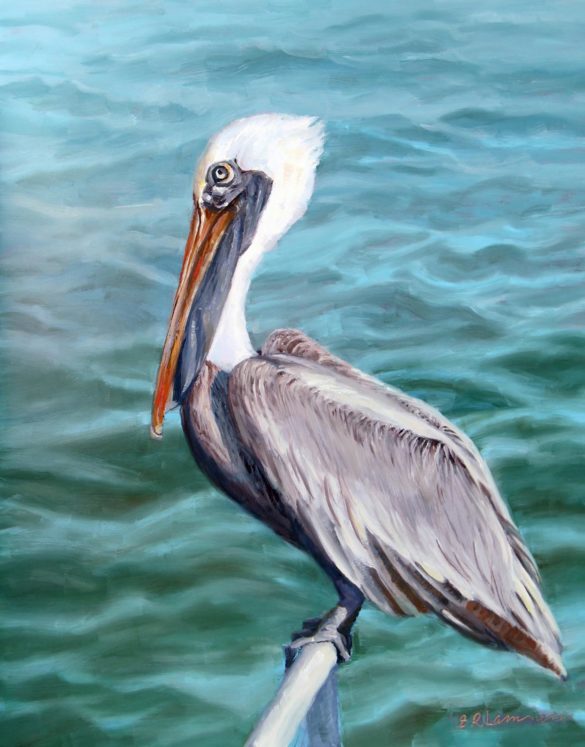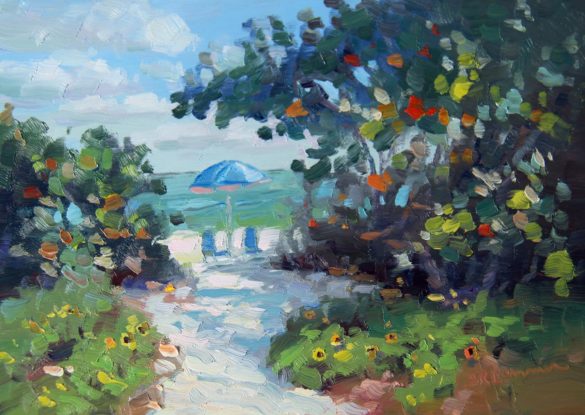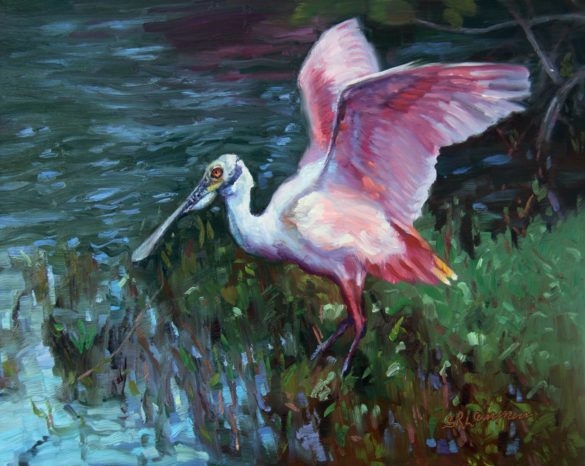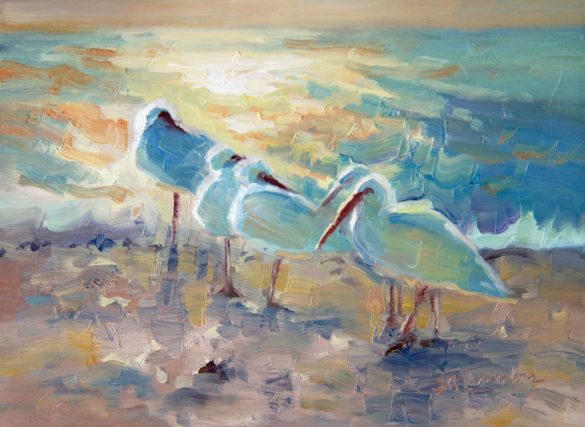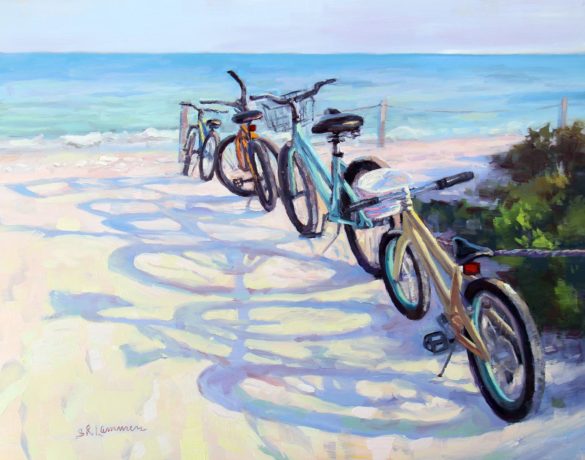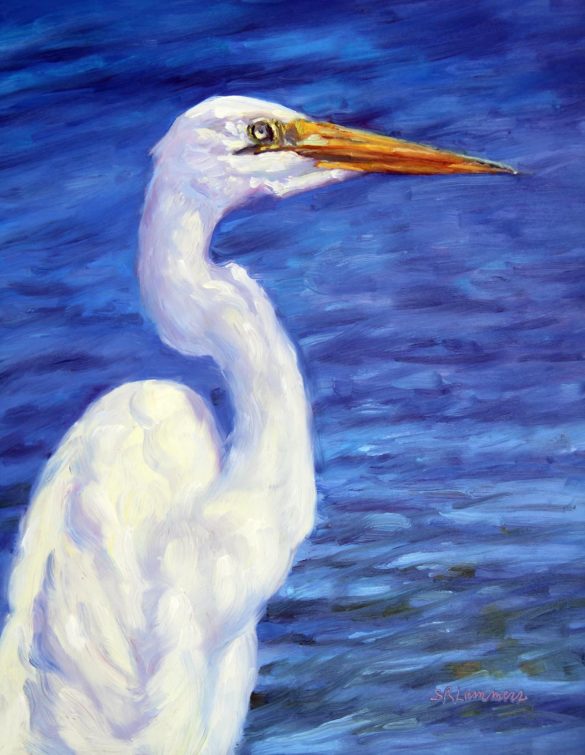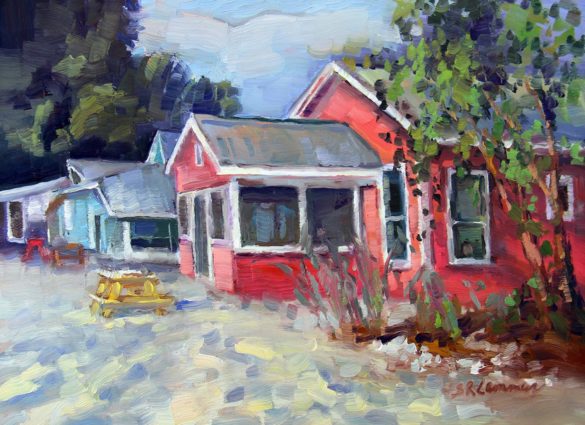For this Sanibel Art Colony showcase, we are shining a spotlight on the work of artist Susan Renee Lammers.
Lammers is a plein air painter who works in oils. Her palette is vibrant and her work conveys a vivid sense of place. Her subjects are strong. Birds. Boats. Bicycles. Beach chairs. Blossoms. Drying laundry billowing in the breeze. Cozy homes. Iconic landscapes. Listening, glinting light. Her love of all things ocean is tangible. As is her love for two of the most beautiful areas on earth: coastal Maine and Sanibel + Captiva in southwest Florida.
RELATED: Join our BRAND NEW Sanibel + Captiva Island Art + Photography Group
ALSO RELATED: Connect with @sanibel_barometer on Instagram
That’s why it seemed high time for me to finally corner artist Susan Renee Lammers and learn a little more about the work she does — and her connections to Sanibel and Captiva
ARTISTS: Are you an artist who creates work depicting Sanibel Island (or the surrounding areas) and is seeking to reach a wider audience? CLICK HERE to Contact Sanibel Barometer today and ask us how we may be able to help!
Keep scrolling down after my interview with artist Susan Renee Lammers to see some of her Sanibel-area paintings!
A Conversation With Artist, Susan Renee Lammers
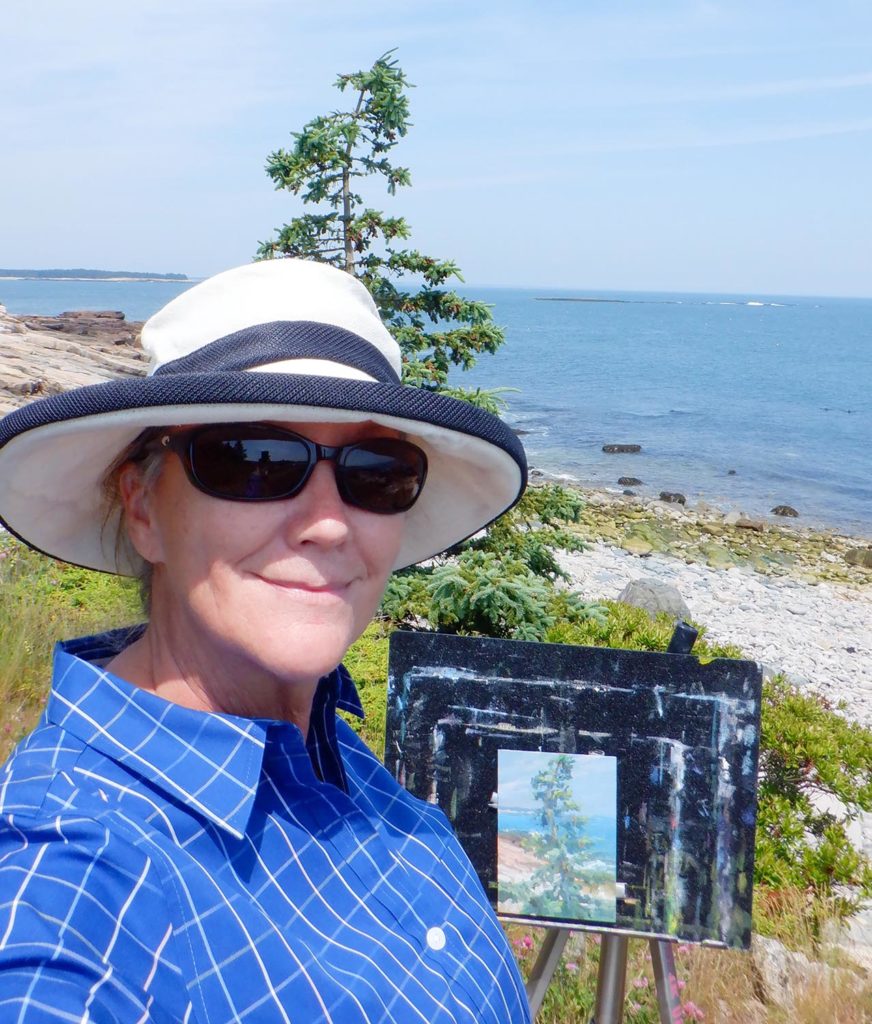
Can you speak a little to your background and the types of work you are best known for?
I had a giant box of coloring books but did not dare to mess them up. I carried them around showing them to anyone who would take a look. I was a young art collector. Instead of coloring, I loved to draw animals from my imagination and add color. My Mom had me painting the still lifes she set up at four years of age! I was inspired by many different artists my Mom exposed me to along the journey.
My first professional painting instructor was Daniel Greene. I was 12 years old. He answered my questions patiently and with great thought.
The next 25 years I studied watercolors with 30 top artists from around the world. I flew to Oregon to study for two weeks with Arne Westerman. I went to New Mexico to study with Jan Kunz. I went to Italy to study with Robert Wade, an Australian artist. Then I transitioned into studying Fine Art at Stetson University with Art Professor Gary Bolding. I started to paint with oils again on gessoed 3/4 inch birchwood. The surface had to be smooth like an egg shell. Preparation of this substrate took weeks! We painted the still life. I was also studying Pre-med Biology along with the Fine Art at Stetson University. I graduated in 2004 with my Pre-med Degree. I decided to pursue painting as a career. Painting has always been where my heart was.
What brought you to Maine?
In 2007, my husband Robert, and two golden retrievers, Daisy and Duke, purchased a brand new 25-foot Airstream International RV trailer, sold our house, and drove to Maine. We lived in the Airstream for 2 years. We battled many winter storms. We did fine! I drove all over Mount Desert Island painting plein air (outdoors) every day! We purchased a house in 2009. I opened a gallery in the front of our house in 2010.
I drove to Stonington, Camden, Castine, and other cities in Maine to paint plein air. On rainy days, I worked in my studio. Everyday I was painting 10 hours a day. Stapleton Kearns mentored me beginning in 2010. He picked me up in a pearl colored Cadillac, drove me an hour and a half to Mount Desert Island, where we painted for 10 hours a day! During the drive he taught me information about how to be a successful working painter. One of the ideas was to work with a very limited palette. Having four colors would teach me how to actually mix colors and create a very harmonious painting. Another idea was to work with a big brush to learn brush technique. The brush would not control me: I would control the brush! I am forever grateful for the time and effort Stapleton Kearns spent with me. Through his friendship I met other fantastic painters who further shared their knowledge with me.
How did you come to be painting so often on Sanibel and Captiva Island over the past couple of years?
In 2021, I decided to buy a tiny mobile home in Fort Myers, Florida so that I might have a Winter studio. I’m a third generation Floridian. I missed Florida. Maine winters are tough!
I made the journey from Maine to Florida with my two cats, Festus, a Maine Coon cat, who weights 20 pounds, and Miss Kitty, an orange tabby who weights 6 pounds. Festus met Miss Kitty during one of our outings in the cat stroller. He chirped and chirped at her. She came to dinner two nights in a row. She moved in. Festus is a much happier cat now that he has Miss Kitty. We are all much happier.
I also have four golden retrievers, the Father Monet, the Mother Poppy, their Daughter Lily, and their Granddaughter Lady Violet. My husband Robert stays in Maine during the winter with the dogs while I stay in Florida with the cats.
I stay in Florida each year from November 1 to June 1. While I’m in Florida, I drive to Sanibel Island and paint twice a week. I also admit to spending many hours walking along the beach shelling, taking photos, swimming, and admiring birds!
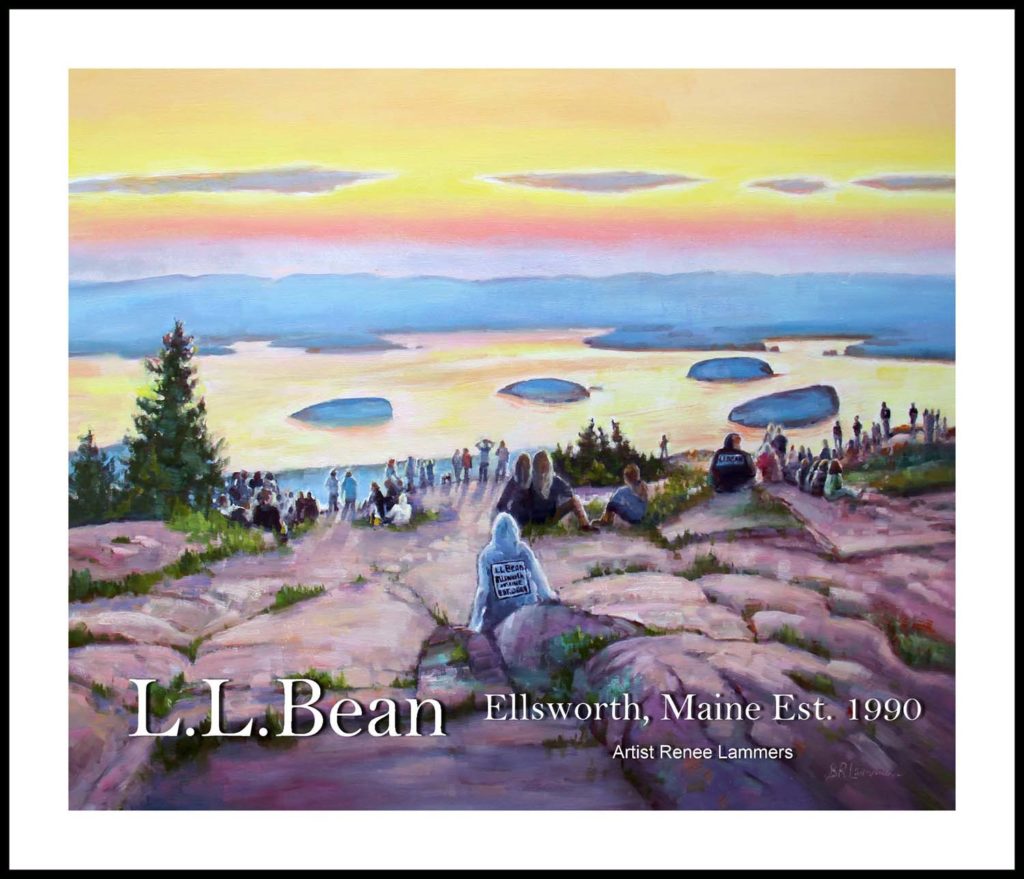
I saw you recently partnered with LL Bean, a true badge of honor for any Maine artist. Can you share a little bit about that scenario with us?
I was asked to paint a sunrise image from Cadillac Mountain for L.L. Bean’s Ellsworth, Maine store. I took a few liberties with the image. I added a few LL Bean logos to two shirts. I painted two people wearing L.L. Bean boots. I added a few L.L. Bean backpacks. It was a big hit! I love doing work for companies. Jackson Laboratory on Mount Desert Island purchased an image from my painting collection. They produced 100,000 posters, 300,000 emails, and created two different magazine adds. Hinckley Yachts also used a painting image of mine for brochure, emails, and marketing.
How have Sanibel and Captiva Island had an impact on your art?
Sanibel and Captiva Island have always been magical. When I lived in Winter Park, Captiva Island was my favorite vacation spot. Now that I am living in Fort Myers, I have found visiting Sanibel and Captiva perfect for painting. The light is stunning. It is so much brighter. Sanibel is very diverse as far as the landscape and seascape. I travel to five or six spots to check the views. It is very exciting. My only limitation has been parking. This year I will purchase a Sanibel Island parking pass if possible.
Let’s talk about your favorites on Sanibel or Captiva! Do you have any preferred places to relax, restaurants, places to paint, places to watch the sunset…
I love painting at the first island (Island “A”) on the Sanibel Causeway. I’m often at Turner Pass Beach on Captiva. I love to paint the pink cottage on Sanibel Island. I often paint views from the West Wind Inn. Ding Darling Preserve is a favorite. I am grateful for Dairy Queen. I love the Bubble Room Restaurant.
I understand you paint quite often with oil on copper. Can you explain why you use copper as a surface?
In 2007 I spent many days in museums studying paintings and their substrates (canvas, linen, board, copper) I was in the Boston Museum of Fine Art one day. I saw a painting by Frans Snyder depicting a bowl of fruit with a squirrel on top. The red oil paint glowed. I remember reading the label, Oil on Copper. I wrote that down. I unlined this twice. What amazed me was the surface of the painting. The surface was flawless! It was 600 years old. Other paintings had not faired as well.
In 2008 I was in the Rijks Museum in Holland. There were 140 oil on copper paintings on display. These paintings were in perfect condition. I asked my husband, Robert, who is Dutch, to ask the Museum Curator about these oil on copper paintings. She explained the reason oil on copper paintings are so well preserved. The oil paint and the heat constant of the copper panel are almost the same. When temperatures fluctuate they expand and contract together. The results are a very archival substrate.
Leonard Da Vinci did studies on substrate in the 1500s. He thought copper was the most archival substrate. Dutch masters started to paint on copper. Churches preferred copper paintings. I went home pondering about copper.
There is only one book, now out of print, entitled “Copper As Canvas” by the Phoenix Museum.
There are four different methods to paint on copper. I chose the best way. I sand down the copper panel. I paint with oils. I varnish with a non-yellowing resin. All the copper is sealed from the elements. No copper turns green or brown. There is a wonderful very slight shimmery quality to oil on copper paintings.
Tell me about a specific artwork you were exposed to at some point that had an impact on your life or your work. What did it teach you?
Frans Snyder‘s painting, which I have already mentioned, was monumental in changing my substrate. Aldro Hibbard and Willard Metcalf are two impressionist painters I most love. I learned how to better design paintings. Nature is not always perfect. I learned to take out trees, move things around, to create a better painting.
If you could go back to the beginning of your journey as an artist – what is the one piece of advice you’d give your former self?
Paint small plein air works. Create large works in the studio after many plein air paintings have been done on location to use as a reference. Be careful choosing friends in the business. Be independent.
What are you most proud about in your painting career, so far?
I am proud of my work ethic. I am proud of maintaining a blog for over ten years. I feel very honored to have met fantastic people who have purchased my paintings. Art patrons are a very elite successful group of people I would never had the ability to meet if I were not an artist.
What does artist Susan Renee Lammers have in store for the future?
I would like to start teaching plein air painting. I have asked the Ford Edison Museum if they might be interested in plein air classes for adults and teenagers. I would also like to write a few books: How to Sell Paintings. How To Paint with Oils on Copper.
Where can we see more of your work – online or in person?
I prefer to sell my work online reneelammers.com I do have my work available to see upon request on Sanibel Island and in Bucksport, Maine. On my website is a contact the artist button. Or I can be contacted by phone at (207) 479-9553. Or email: theartistrenee@aol.com
Work by artist Susan Renee Lammers | Click any image below for a larger view
About Sanibel Art Colony
The Sanibel Barometer aspires to elevate the recognition and appreciation of all artists (in all disciplines) who have a connection with Sanibel Island.
With our “Sanibel Art Colony” features, the Sanibel Barometer aims to showcase the artwork, processes, and personalities of artists who are actively creating art in, depicting, and/or inspired by Sanibel Island (and the surrounding areas) in southwest Florida. Some of the artists we’ll be featuring live here full time. Others may live here for half the year – or even just vacation here for a few days or weeks each year. We’ll also be focusing on the history of artwork connected to Sanibel Island. The goal with our “Sanibel Art Colony” initiative is to give a deeper and more inclusive sense of community to ALL artists, in ALL disciplines, and from ALL places who hold a special pace in their artwork for Sanibel island.
Whether you are someone who appreciates seeing Sanibel Art Colony work, a collector who would like to purchase Sanibel-inspired artwork, or an artist who would like to share some of their work which was created in, depicting, and/or inspired by Sanibel Island (and the surrounding areas) in southwest Florida; we’d LOVE to have you join our NEW Sanibel Art Colony Facebook Group at facebook.com/groups/sanibelartcolony
Disclaimer: Information is harvested (at time of publication) from publicly available sources and is deemed reliable but not guaranteed – any editorial content is solely opinion-based – availability, prices, details, and etc are subject to change or withdrawal at any time and for any reason. All dimensions are approximate and have not been verified. All data should be independently verified.
